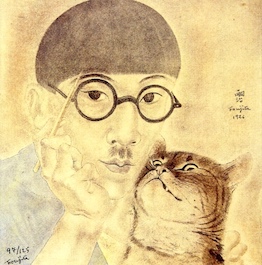Leonard Tsuguharu Foujita
- JOHN JANARO
The artist Leonard Tsuguharu Foujita (1886-1968) experienced both the encounters and the conflicts between East-Asia and the West in the 20th century during his seventy-three-year-long journey to the Catholic Church.
 Leonard Tsuguharu Foujita
Leonard Tsuguharu Foujita 1886–1968
Born in Tokyo, Foujita studied art during Japan's Westernization period, and traveled to Paris in 1913 to perfect his European painting technique. But as he observed and sketched the great masters of European painting at the Louvre, and experienced the chaotic but brilliant creative-explosion that was happening among his fellow artists, Foujita sought freedom for his own creative exploration.
While he plunged into the wild bohemian artistic lifestyle, Foujita didn't follow Parisian art trends. Rather, he developed a unique approach that brought together the techniques of classical Japanese ink drawing, the vivid representational detail of da Vinci and Michelangelo (his favorite Western painters), and modern, avant-garde themes. The result of this synthesis took Paris by storm in the 1920s. Foujita soon became one of France's most famous and wealthiest artists.
But he was not content. In 1931, the restless artist went off to seek new experiences, traveling with his fourth wife (or extended liaison — the record of his civil marriages is sketchy) to the Americas and then back to Japan. Trying to settle down for good, he married a Japanese woman, Kimiyo, and — when his country went to war — became a propaganda artist for the military (though his personal ambivalence seems reflected in the haunting pathos and misery of his war paintings). After the war, with his Japanese artistic rivals condemning him as a "collaborator," Foujita returned to France with Kimiyo.
A conversation about religion ensued, and Foujita revealed with sadness that he wished he could become Catholic, but he assumed his past relationships made it impossible.
He found more stability now, and stronger friendships. Still some unobserved restlessness stirred in the aging artist. On a visit to Reims in 1959, he entered the abbey church one day with his friend, the art critic Georges Prade, who went to light a candle at the tomb of Saint Remi. No one knows exactly what happened next. Foujita was surrounded in that famous church by a thousand years of fascinating art. But something infinitely more profound struck his heart (something he later described as "a vision"), and he asked to light a candle too. A conversation about religion ensued, and Foujita revealed with sadness that he wished he could become Catholic, but he assumed his past relationships made it impossible.
No one knew how long Foujita had nourished this secret desire. But Georges suspected right away that the obstacles troubling the old artist were not real. Reviewing his history of liaisons and civil unions, Georges thought it highly unlikely that any of them prior to his marriage to Kimiyo would be regarded as valid by the Church. He was right: there was no impediment to Foujita's conversion. Without hesitation, Foujita asked for instruction. He and Kimiyo were both baptized on October 14, 1959. He took the name Leonard, after Leonard of Kashima — one of the Nagasaki martyrs who was also an artist — and his hero Leonardo da Vinci.
In gratitude and "in reparation for eighty years of sins," Foujita then took up his last and most profound project: designing and painting the interior of a chapel in Reims dedicated to Our Lady of Peace, where he and his wife are both buried today.
 This is Meaghen Gonzalez, Editor of CERC. I hope you appreciated this piece. We curate these articles especially for believers like you.
This is Meaghen Gonzalez, Editor of CERC. I hope you appreciated this piece. We curate these articles especially for believers like you.
Please show your appreciation by making a $3 donation. CERC is entirely reader supported.

Acknowledgement
 John Janaro "Leonard Tsuguharu Foujita." Magnificat (November, 2019).
John Janaro "Leonard Tsuguharu Foujita." Magnificat (November, 2019).
Reprinted with permission of Magnificat.
The Author

 John Janaro is Associate Professor Emeritus of Theology at Christendom College. He is a Catholic theologian, and a writer, researcher, and lecturer on issues in religion and culture. He is the author of Never Give Up: My Life and God's Mercy and The Created Person and the Mystery of God: The Significance of Religion in Human Life. He is married to Eileen Janaro and has five children.
John Janaro is Associate Professor Emeritus of Theology at Christendom College. He is a Catholic theologian, and a writer, researcher, and lecturer on issues in religion and culture. He is the author of Never Give Up: My Life and God's Mercy and The Created Person and the Mystery of God: The Significance of Religion in Human Life. He is married to Eileen Janaro and has five children.




